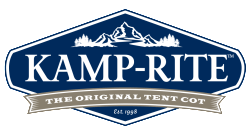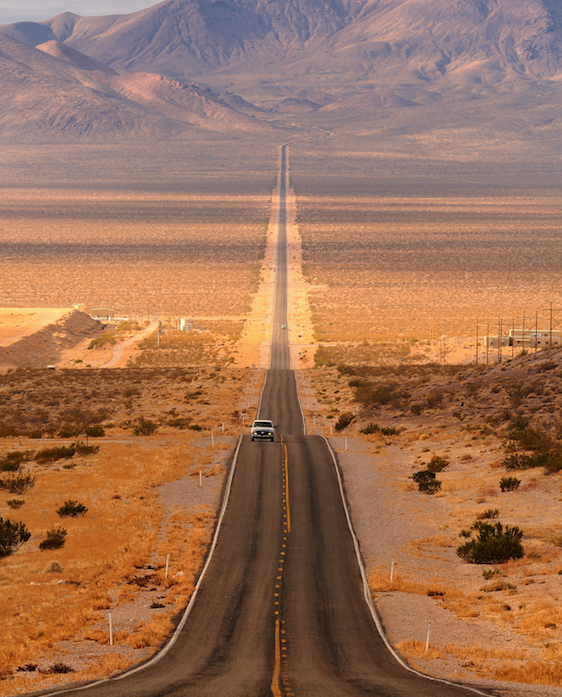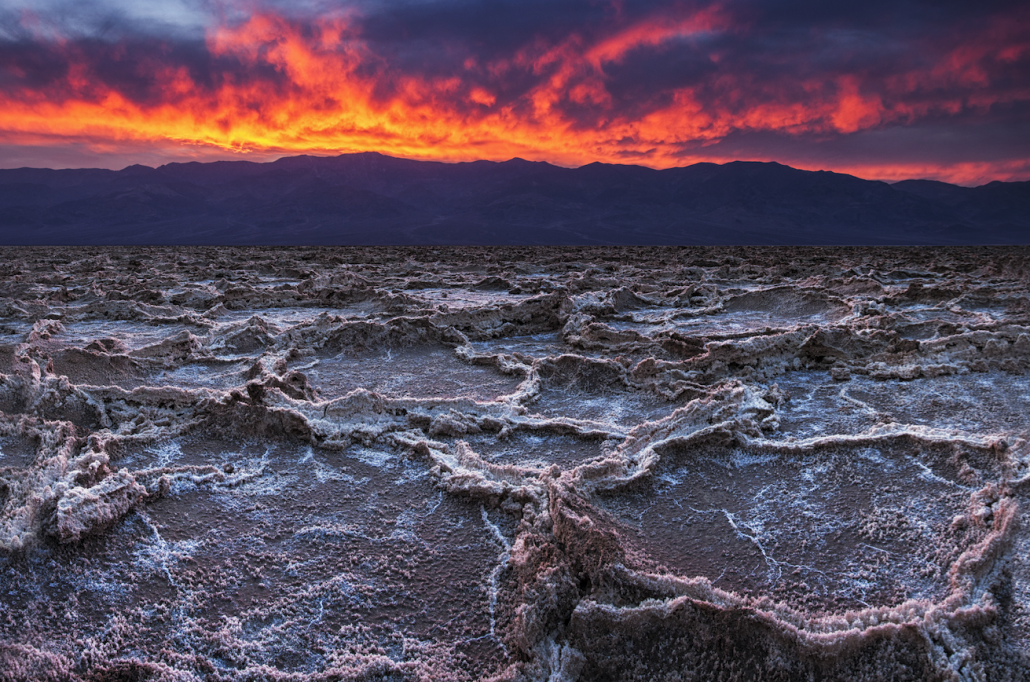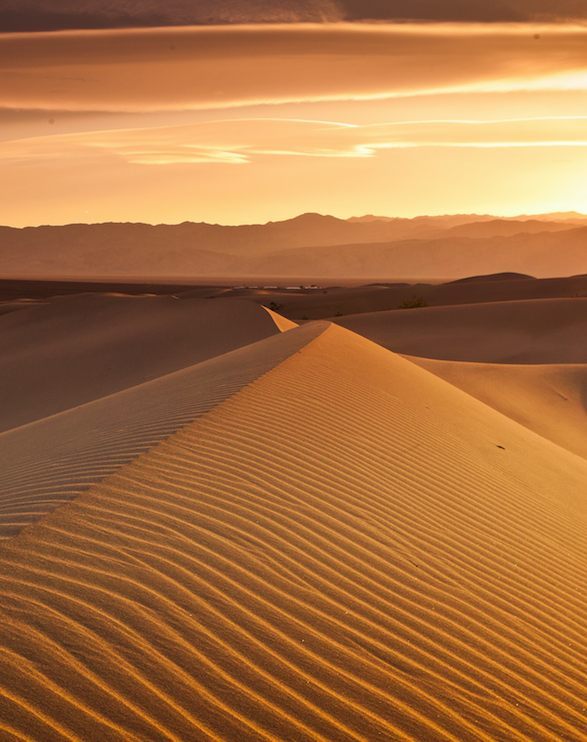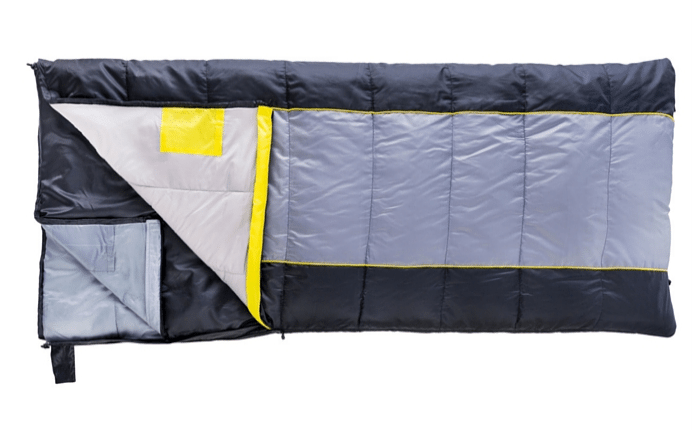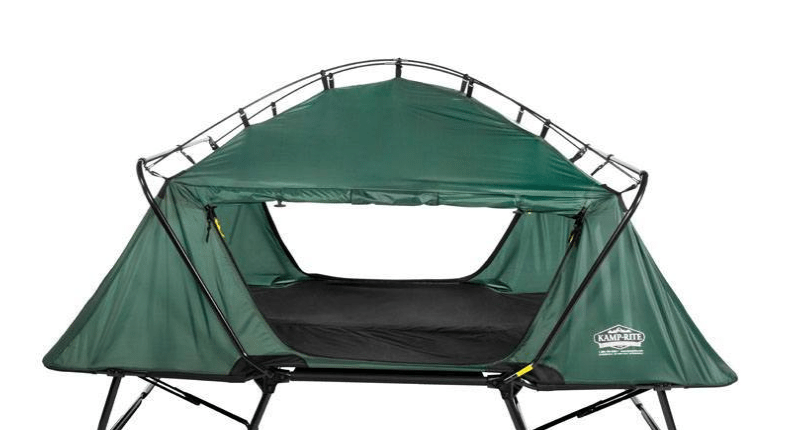Where to Explore
Devil’s Golf Course:
This immense area of salt rock has been eroded away by the wind and rain, turning the rock into jagged spires. It is so eroded that “only the devil himself could play golf on such rough links.” If you turn your ears up to the wind, you can hear tiny pops and pings of his golf balls bouncing about. The sound is literally billions of tiny salt crystals bursting apart as they expand in the heat.
Badwater Basin:
Believe it or not, this is the lowest point in North America. The Basin sits 282 feet below sea level. This surreal landscape of vast salt flats is not recommended in the summer, so now would be the perfect time to explore it.
Zabriskie Point:
This is by far the most famous lookout in Death Valley. It overlooks the golden colored badlands of the Furnace Creek formation and visitors can simply enjoy the view or go for a hike from the point around the Badlands Loop. The connecting trails lead to Golden Canyon, Gower Gulch and Red Cathedral.
Twenty Mule Team Canyon:
Do you like to travel with a furry companion? This trail would be a great place to take your dogs or even just take a hike or a bike ride. Winding through these badlands will take you on a 2.7 mile loop. Sedans can pass through it, but we wouldn’t suggest trying to bring vehicles over 25 feet long on this adventure.
Dante’s View:
Dante’s View is the most breathtaking viewpoint in the park. Facing west, the Panamint Mountains are in plain sight. This lookout offers the most breathtaking sunrises in the park. The Sierra Nevada is barely visible on the horizon. Unfold your Ultra Lite Chairs and enjoy the view.
Where to Kamp
Furnace Creek:
This is the central location of Death Valley National Park. Although it is most popular amongst RVs and group campers, tent sites are still available. Furnace Creek is the only campground in the park that takes reservations. Explorers of all ages can enjoy educational programs and exhibits at the visitor center. Bird watchers might also have luck spotting migratory birds around the campground, especially during these cooler months.
Texas Springs:
This space may look a little desolate, but that makes it a great place to enjoy some much-needed serenity. There is gravel paving the camping site, so any of our tent cots would be perfect to get you off the hard ground. This campsite is near popular hikes, such as Golden Canyon to Zabriskie Point or geological wonders like Badwater Basin and Devils Golf Course.
Stovepipe Wells:
This campground has been compared to the Australian Outback with the beauty of its nothingness. This is the campsite to visit if you are RVing. Spots fill up quickly so be sure to make a reservation. The RV park includes access to the swimming pool and to multiple restaurants and saloons.
Mesquite Spring:
This campground sits 2,000 feet higher than the Badwater Basin, which makes it a lot cooler in the winter months. Be sure to pack one of the 0-Degree sleeping bags to stay nice and toasty. The site is much less frequented and is off the beaten path, but it’s worth it because the view from this campsite is nothing less than spectacular.
Wildrose Campground:
Located between the impressive Panamint Range near the very edge of Death Valley National Park, this campground provides you with a magical camping experience. Its 23 campsites are highly coveted because they are positioned near some beautiful hiking trails. This is a “tent only” campsite.
What To Do
Star Gazing:
Where to star gaze all depends on the moon and its schedule, but we have a few suggestions. If the moon is big and bright, we recommend you head towards Mesquite Flats, and if it is not, head to the airport near Furnace Creek. Zabriskie Point is about 700 feet above sea level and closer to the stars. Another spectacular view is available at Dante’s View, which is 5,475 feet above sea level and easily accessible. From this peak, you can look to the Southeast and get a glimpse of the dull glow of Las Vegas!
Day Hikes:
Many of Death Valley National Park’s trails are easy-to-moderate in difficulty. The best seasons to hike the desert are in fall and winter. Most trails are a half-to-six miles long. Some favorite trails include, Hungry Bill’s Ranch, Ashford Canyon, Golden Canyon, Darwin Falls and Salt Creek.
Sand Dunes:
You cannot go into the desert without visiting sand dunes. The Mesquite Flats Sand Dunes are easily accessible and perfect for photography. The Eureka Dunes are not a popular as Mesquite Flats’ just because of the long drive in, but if you’re looking for something isolated and breathtaking, you can find your peaceful moments here.
ATV, 4WD & Off-Road Tours:
Don’t want to walk the valley? That’s okay because you can drive it! There are plenty of companies that give tours via Hummers, ATVs or even luxury vans. You can sign up for a full day tour or just for a few hours. There are plenty of options!
The Essentials
Tent Cot (Original or Double Tent Cot):
The desert floor can be hard and some of the campsites are on gravel. We want to make sure you stay off the ground and have a good night’s rest because there is so much to see and do in the Death Valley National Park.
3-in-1 Sleeping Bag:
The weather varies here. The days are warm and the nights can be very cold depending on the elevation. For this reason, we suggest playing it safe and bringing along our 3-in-1 Sleeping Bag, which gives you three different options for your level of warmth.
Ultra-Lite Chair:
This is the chair you want to take along with you on any hike! It is only three pounds and can be set up in seconds so you can enjoy the view in comfort. We suggest you take it star gazing, as well!
